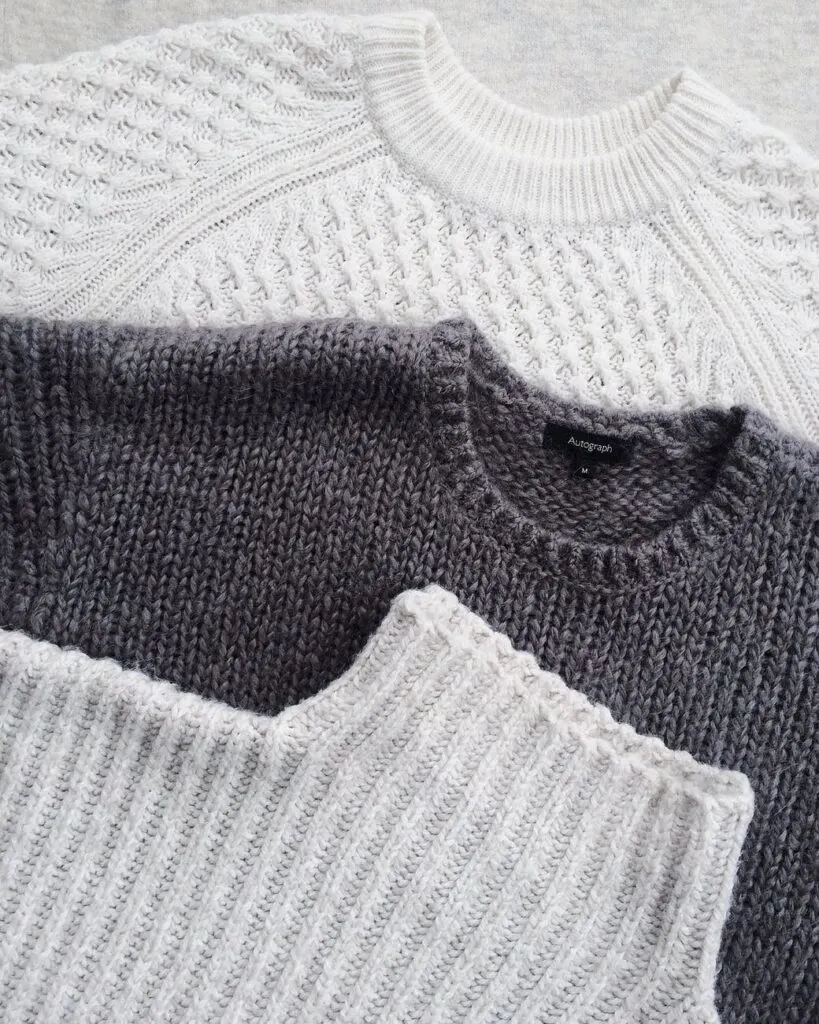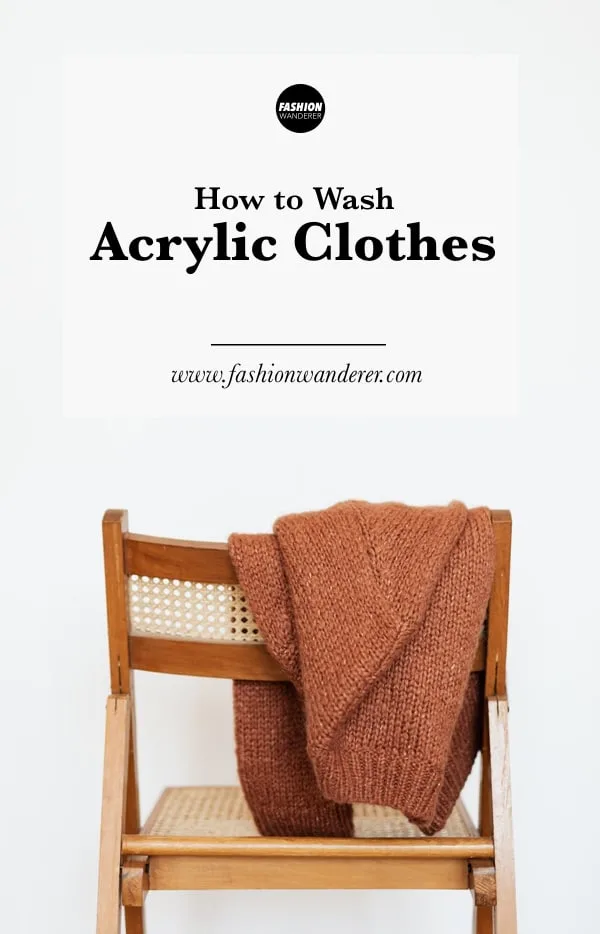Select the proper washing instruction when caring for and maintaining your favorite acrylic clothing. Here is exactly how to wash acrylic clothes in order to prevent stretching out your acrylic garments. Clothing care starts by thoroughly understanding the fabric.
Successfully retain the shape, size, and durability of acrylic apparel by washing in warm water and drying on low heat. In order to preserve the silhouette, it is best to avoid hanging to dry. Instead, tumble dry on low heat or dry flat on a rack.
After understanding what acrylic fabric is and how acrylic fibers are made, then the specific washing instructions will become clearer. Each fabric and material requires special clothing cleaning tips. Let’s dive deeper into the subject to learn about the manufacturing process of acrylic, and how acrylic fabric is made.
What is acrylic fabric?
Acrylic fabric is a synthetic fiber that is made of woven plastic threads. Acrylic fiber is mass-produced into a thin strand, which is then stretched, washed, cut and spun into yarn to make clothing.
In the US, the polymer must contain at least 85% acrylonitrile in order to be called acrylic. The manmade polymer is created from fossil fuels through a chemical process that resembles the production of nylon and polyester.
Acrylic fabric is lightweight, soft and warm. It feels like wool and also mimics other fibers like cotton when spun into yarn. As a result, it is commonly used to make sweaters, hats, socks, tracksuits and the lining inside boots and gloves.
How is acrylic fiber made?
Plastics are manufactured from natural and organic materials like cellulose, coal, natural gas, salt, and crude oil. Heat and pressure are applied using energy, which results in polymerization that forms a plastic solution.
Acrylic fibers are a product formed by the polymerization of a plastic solution. DuPont created the first acrylic fibers in 1941 and began manufacturing large quantities in the 1950s.
Acrylonitrile is a colorless and flammable liquid chemical that is derived from a type of plastic known as polypropylene. The monomer is combined with other chemicals to create a polymer.
The plastic solution is spun into a filament using a spinneret, a tool that extrudes the gel-like solution through small holes to produce a thread. The thick solution is dried in a cooler liquid (wet spinning), or air-dried in heated gas (dry spinning), to harden the strand.
How is acrylic fabric made?
The threads are stretched to maximize the length of the strands, which further reduces the overall cost. Afterward, the acrylic fibers are spun into a yarn, loaded onto bobbins, and then shipped to textile manufactures to create a variety of goods.
Apparel manufacturers use acrylic to make everything from sweaters to pants and gloves. Acrylic fabric is the least breathable material and is used as a wool replacement in various types of cold-weather clothing.
Although acrylic resembles wool in its natural state, it can mimic cotton depending on the spinning techniques used in the manufacturing process. As a result, acrylic is often blended into clothing to reduce the cost of the natural fibers.

What are the properties of acrylic fabric?
Acrylic fabric bears a lot of similarity to the appearance and texture of wool. In addition, the acrylic fabric can replicate cotton by adjusting the textile weave in the production process.
Acrylic is commonly found in sweaters, hoodies, hats, and socks. In addition, the material has found its way into athletic clothing because it is lightweight, durable and insulates warmth.
Is acrylic fabric waterproof? Acrylic fabric is durable, stretches and offers waterproof capabilities. Similar to other synthetic materials like polyester and nylon, the acrylic fabric is hydrophobic, which means it repels water.
Because the fabric does not absorb water, bacteria are difficult to remove without the proper methods to wash acrylic clothes. Left unchecked, the bacteria may damage the fabric structure and also cause bad odors to develop.
Is acrylic good for winter?
Acrylic fabric by itself presents many undesirable characteristics. Therefore, acrylic fibers are often blended into both cotton and wool garments because of the close resemblance. This helps to reduce the overall manufacturing cost of natural materials by incorporating a chemical solution.
Combining these materials enhances performance and also boosts insulation properties. When blended with a higher amount of acrylic, both cotton and wool materials are less prone to shrinkage.
However, sweat has a tendency to build up because of the lack of breathability. When layered effectively, acrylic has properties that promote heat insulation in cold weather.
Especially in cold weather, the friction of acrylic fabric creates static electricity resulting in clothing cling. Naturally, remove static buildup from your clothes by following a few simple techniques.
Why is acrylic used instead of wool? As opposed to wool, acrylics materials are also considered highly flammable and present extreme risks because it is hard to extinguish. In contrast, wool is difficult to light and is much easier to put out.
Acrylic is used in place of wool because it is a synthetic material that is cheaper to manufacture. Acrylic is lightweight, wrinkle-free and also retains heat. The material is also soft, durable and resistant to moths.
Wool is considered a better material than acrylic. 100% wool will last longer, however, it will be more expensive and harder to care for.
Is acrylic warmer than wool? Wool allows breathability that is not available in synthetic materials. Wool also wicks away moisture when perspiration begins to buildup. Because acrylic fabric does not breathe in a similar manner, it traps more heat and feels warmer than wool.
Is acrylic warmer than cotton? Similar to wool, cotton has the ability to provide breathability and also absorb moisture. Therefore, it helps keep you comfortable and dry by wicking moisture away from the body.
The acrylic fabric keeps you warmer than cotton because it lacks the ability to allow air to pass through. Therefore, the material insulates the body to trap in heat.

Does Acrylic Shrink?
Garments made of natural fibers like cotton and wool tend to shrink when washed in hot water or dried with high heat. Acrylic is a synthetic material that reacts in the complete opposite manner. Acrylic does not shrink and actually stretches out when exposed to high temperatures.
Rather than trying to shrink acrylic clothes, you will be much better off exchanging your oversized acrylic sweater for one that fits you better. Furthermore, consider working with a tailor to resize for a perfect fit.
Is acrylic material stretchy? Acrylic is not stretchy like elastic, however, it does stretch out when in contact with high heat. Therefore, it is extremely important to wash acrylic clothes the right way to prevent disfiguring the silhouette.
Successfully retain the shape, size, and durability when you wash acrylic clothes in warm water and dry with low heat. In order to preserve the shape, it is also best to avoid hanging to dry.

How To Wash Acrylic Garments
Acrylic clothing will last a long time if properly cared for. It is important to recognize that both cold and hot water can damage the acrylic fabric. Heat can quickly alter the synthetic fibers; therefore, it is recommended to always wash acrylic clothes in warm water and tumble dry with low heat.
When the acrylic fabric is washed in cold water, it becomes brittle and unbending. Acrylic fabric that is exposed to high heat can melt and cause damage to the washing machine, dryer, and the other articles inside. Prevent stretching by taking simple precautions when washing acrylic clothing at home and also never hang to dry.
Check the label
Verify the fabric content and also check the washing instructions of the garment. Machine wash 100% acrylic clothes in a different setting than you wash jeans and cotton shirts.
Use delicate or permanent press setting
Wash with warm water, if not otherwise indicated in the washing instructions on the tag. To prevent stretching the size of your garments in the washing machine, place a half dozen other items inside as well.
Use mild detergents
Use a mild homemade laundry detergent and fabric softener when washing. Strong soaps are abrasive for acrylics fabrics.
Dry with low heat
Lay the acrylic garment flat on a drying rack, or tumble dry on low heat. When using a dryer machine, leave acrylic clothing inside for 30 minutes or less, then air dry to finish.
Pro tip: Hangers and high heat dryers are the primary cause of acrylic clothing to become stretched out.
Use a steamer
An iron will damage the acrylic fabric. Use a steamer on a low setting to remove any wrinkles from acrylic clothing. Do not hold the steamer in a single area for an extended period of time, and only go over the same spot a maximum of two to three times.
Wash your acrylic clothes the right way to prevent garments from losing their form. While it is common to wash clothing made with natural materials every two to three uses, synthetic materials can withstand four to five years because they are far more durable.
How do you wash your acrylic garments?
Share your acrylic washing tips and hacks with us!
